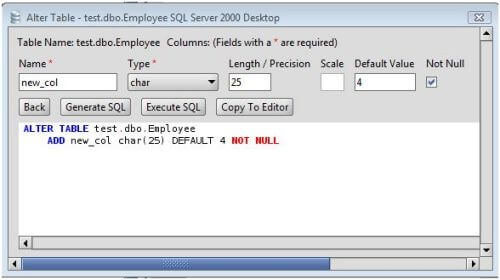

We pointed out that some functions of the ALTER statement don’t work on specific databases. Depending on the database you’re using will depend on how far its application goes. SELECT COLUMNNAME FROM INFORMATIONSCHEMA. Whether we are adding, removing, or modifying columns in a table – the ALTER TABLE command has you covered. If it didnt return any rows then the column doesnt exists then alter the table: ALTER TABLE tblname ADD COLUMN columnname TINYINT (1) NOT NULL DEFAULT 1. RENAME column_name TO new_column_name - MySQL, Oracle, PostgreSQL, SQLite, and others For instance, if we use SQL Server with SSMS it will only support its own built in function.ĮXEC sp_rename ‘. Every other query that touches the table needs a Schema Stability Lock (Sch-S). The ALTER command only supports renaming columns for certain databases. How will SQL Server queue this request (eg First In First Out) Can I be sure the DROP COLUMN will truly only take a few moments The way the locking works for ALTER TABLE is that you need a Schema Modification Lock (Sch-M) to perform the ALTER. We can also use a variation of the command if we need to modify a datatype or setting such as NOT NULL to a column.ĪLTER COLUMN TYPE datatype - PostgreSQL In that case we’d need permissions from a database admin.

It’s also typical to not have privileges to drop columns. Note: SQLite does not support the dropping of columns. Instead of adding we can also remove unwanted columns from our tables.ĭROP COLUMN - Alter Table Drop Column Syntax CREATE TABLE srelationsnew LIKE srelations Drop Duplicate Indexes ALTER TABLE srelationsnew DROP INDEX sourcepersonaindex, DROP INDEX targetpersonaindex, DROP INDEX. Here are the initial steps to load a new version of the table. We can add either single or multiple columns using the ALTER TABLE ADD column syntax.ĪDD datatype - Alter Table Add Column SyntaxĮxample: Dropping, Modifying, and Renaming Columns One sure way to speed up an ALTER TABLE is to remove unnecessary indexes. Similarly we can also use alter to rename columns. We can also use ALTER to modify an existing column if a change is needed. The ALTER command is considered part of a DDL statement since it modifies the structure of a table. We can use the ALTER TABLE command to either add or remove columns in SQL.


 0 kommentar(er)
0 kommentar(er)
